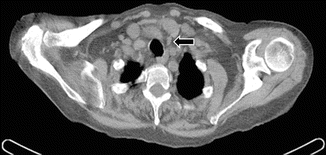Fig. 3.1
Enlarged and inhomogeneous thyroid mass with extension to the mediastinal region imaged by contrast-enhanced computed tomography (white arrows). Enlarged cervical and mediastinal lymph nodes are also evident (black arrows)
Furthermore CT scan can also be used to evaluate extrathyroidal manifestations of thyroid disorders. For example, in patients with Graves’ orbitopathy, CT provides precise imaging of the osseous periorbital structures [3].
Overall CT is not as sensitive as ultrasonography or scintigraphy for the evaluation of intrathyroidal lesions, but it can show enlarged cervical lymph nodes, evaluate thyroid tumor extension in the surrounding tissues, and detect distant metastases (Fig. 3.1) [4].
Lastly hybrid tomographs such as single-photon computed emission tomography (SPECT)/CT and positron emission tomography/CT provide combined morphological and functional information in thyroid diseases. The CT portion provides the structural map to accurately localize the radiotracer uptake site [5, 6].
For MRI dedicated surface coil centered over the thyroid gland is needed and generally used for specific indications, including the evaluation of substernal goiters and their relation to other structures, assessment of the local extent, and localization of recurrent sites in thyroid tumors [1]. The normal thyroid gland has homogeneous signal intensity slightly greater than neck musculature in T1-weighted images. Normal thyroid glands appear as hyperintense in T2-weighted images. Thyroid carcinomas are isointense or slightly hypointense lesions on T1-weighted images and hyperintense lesions on T2-weighted images compared with normal thyroid tissue [1].
MRI has also been used for the investigation of congenital disorders of the thyroid gland and the evaluation of diffuse thyroid diseases, such as Graves’ disease, Hashimoto and Riedel thyroiditis, and hemochromatosis [7].
3.2 CT and MRI in Parathyroid Diseases
Thin-cut, contrast-enhanced CT from the base of the skull to the mediastinum can be used to detect hypefunctioning parathyroid glands (Fig. 3.2). Parathyroid adenomas have low density on CT scans and show intense enhancement during the arterial phase [1, 8].


Fig. 3.2
Parathyroid adenoma imaged by computed tomography (arrow)
An emerging technique for the evaluation of initial, recurrent, persistent primary hyperparathyroidism and for preoperative localization of hyperfunctioning parathyroid glands is four-dimensional CT (4D CT) [9]. Although 4D CT may be comparable or even superior to other imaging techniques for the detection of abnormal parathyroid tissue, further cost analysis and large sample studies are needed to recommend it as the imaging modality of choice in the setting of primary hyperparathyroidism [9].
Hybrid tomographs such as SPECT/CT and PET/CT can be used to detect hyperfunctioning parathyroid glands. In particular 99mTc-MIBI SPECT/CT has high detection rate for hyperfunctioning parathyroid glands in patients with primary hyperparathyroidism [10], including ectopic glands. Moreover, the detection rate of 99mTc-MIBI SPECT/CT to identify solitary parathyroid adenomas can be increased with the addition of ultrasonography [10].
PET/CT with 11C-methionine could be helpful in patients with diagnosis of primary hyperparathyroidism when conventional imaging techniques are negative or inconclusive in localizing parathyroid adenomas [11].
< div class='tao-gold-member'>
Only gold members can continue reading. Log In or Register to continue
Stay updated, free articles. Join our Telegram channel

Full access? Get Clinical Tree


